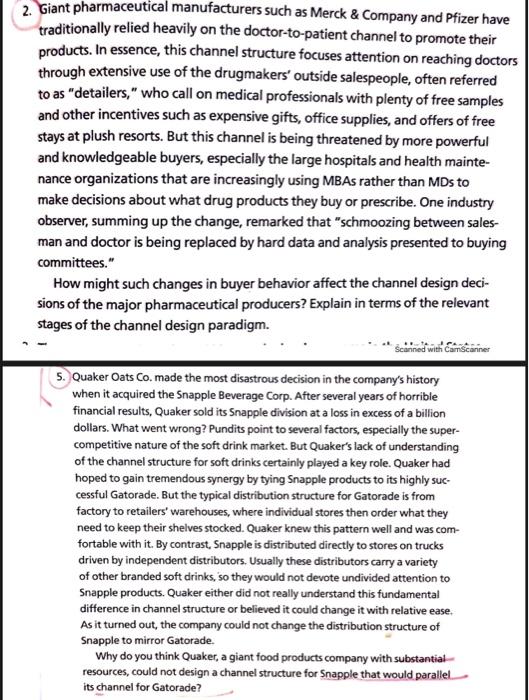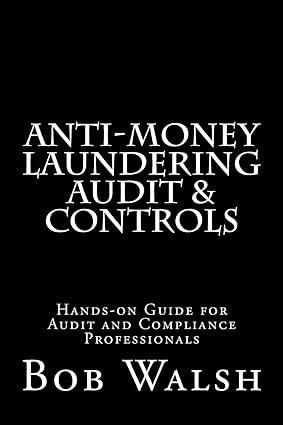2. Giant pharmaceutical manufacturers such as Merck \& Company and Pfizer have traditionally relied heavily on the doctor-to-patient channel to promote their products. In essence, this channel structure focuses attention on reaching doctors through extensive use of the drugmakers' outside salespeople, often referred to as "detailers," who call on medical professionals with plenty of free samples and other incentives such as expensive gifts, office supplies, and offers of free stays at plush resorts. But this channel is being threatened by more powerful and knowledgeable buyers, especially the large hospitals and health maintenance organizations that are increasingly using MBAs rather than MDs to make decisions about what drug products they buy or prescribe. One industry observer, summing up the change, remarked that "schmoozing between salesman and doctor is being replaced by hard data and analysis presented to buying committees." How might such changes in buyer behavior affect the channel design decisions of the major pharmaceutical producers? Explain in terms of the relevant stages of the channel design paradigm. 5. Quaker Oats Co. made the most disastrous decision in the company's history when it acquired the Snapple Beverage Corp. After several years of horrible financial results, Quaker sold its Snapple division at a loss in excess of a billion dollars. What went wrong? Pundits point to several factors, especially the supercompetitive nature of the soft drink market. But Quaker's lack of understanding of the channel structure for soft drinks certainly played a key role. Quaker had hoped to gain tremendous synergy by tying Snapple products to its highly successful Gatorade. But the typical distribution structure for Gatorade is from factory to retailers' warehouses, where individual stores then order what they need to keep their shelves stocked. Quaker knew this pattern well and was comfortable with it. By contrast, Snapple is distributed directly to stores on trucks driven by independent distributors. Usually these distributors carry a variety of other branded soft drinks, so they would not devote undivided attention to Snapple products. Quaker either did not really understand this fundamental difference in channel structure or believed it could change it with relative ease. As it turned out, the company could not change the distribution structure of Snapple to mirror Gatorade. Why do you think Quaker, a giant food products company with substantial resources, could not design a channel structure for Snapple that would parallel. its channel for Gatorade? 2. Giant pharmaceutical manufacturers such as Merck \& Company and Pfizer have traditionally relied heavily on the doctor-to-patient channel to promote their products. In essence, this channel structure focuses attention on reaching doctors through extensive use of the drugmakers' outside salespeople, often referred to as "detailers," who call on medical professionals with plenty of free samples and other incentives such as expensive gifts, office supplies, and offers of free stays at plush resorts. But this channel is being threatened by more powerful and knowledgeable buyers, especially the large hospitals and health maintenance organizations that are increasingly using MBAs rather than MDs to make decisions about what drug products they buy or prescribe. One industry observer, summing up the change, remarked that "schmoozing between salesman and doctor is being replaced by hard data and analysis presented to buying committees." How might such changes in buyer behavior affect the channel design decisions of the major pharmaceutical producers? Explain in terms of the relevant stages of the channel design paradigm. 5. Quaker Oats Co. made the most disastrous decision in the company's history when it acquired the Snapple Beverage Corp. After several years of horrible financial results, Quaker sold its Snapple division at a loss in excess of a billion dollars. What went wrong? Pundits point to several factors, especially the supercompetitive nature of the soft drink market. But Quaker's lack of understanding of the channel structure for soft drinks certainly played a key role. Quaker had hoped to gain tremendous synergy by tying Snapple products to its highly successful Gatorade. But the typical distribution structure for Gatorade is from factory to retailers' warehouses, where individual stores then order what they need to keep their shelves stocked. Quaker knew this pattern well and was comfortable with it. By contrast, Snapple is distributed directly to stores on trucks driven by independent distributors. Usually these distributors carry a variety of other branded soft drinks, so they would not devote undivided attention to Snapple products. Quaker either did not really understand this fundamental difference in channel structure or believed it could change it with relative ease. As it turned out, the company could not change the distribution structure of Snapple to mirror Gatorade. Why do you think Quaker, a giant food products company with substantial resources, could not design a channel structure for Snapple that would parallel. its channel for Gatorade







